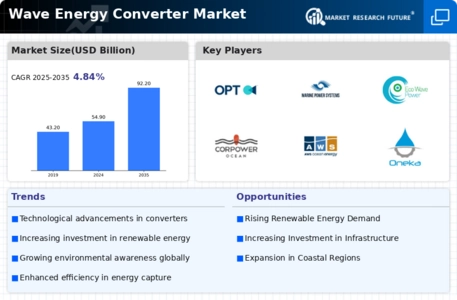Top Industry Leaders in the Wave Energy Converter Market
The Dynamic Terrain of the Wave Energy Converter Market
In the nascent phases of its existence, the wave energy converter (WEC) sphere presents itself as an abundant reservoir of potential as a renewable energy source. Its capacity to tap into the vast energy reservoirs contained within ocean waves serves as an eco-friendly and sustainable alternative to conventional energy sources, drawing a myriad of participants into this burgeoning domain.
Key Contenders:
- Ocean Power Technologies
- Marine Power Systems
- Eco Wave Power
- SINN Power GmbH
- NEMOS GmbH
- INGINE Inc.
- Carnegie Clean Energy
- CorPower Ocean
- AW-Energy Oy
- AWS Ocean Energy
Within the WEC realm, an array of established enterprises and research institutions currently reign supreme, each armed with its distinctive technology and methodology. Prominent figures in this landscape encompass:
Ocean Power Technologies: A distinguished creator of point absorber WECs, renowned for its Oyster technology showcased in diverse pilot initiatives.
CorPower Ocean: A trailblazer in wave surge converters, offering an innovative WEC technology committed to both high efficiency and scalability.
Wavestar: A leading proponent of oscillating water column WECs, with a focal point on large-scale implementations and seamless grid integration.
Carnegie Clean Energy: A proponent of CETO technology, extending submerged wave energy converters designed for offshore applications.
AquaBuoy: A proponent of point absorber WECs, distinguished for its economically viable and modular design.
Wave Swell Energy: A contributor to oscillating wave surge converters, emphasizing near-shore installations and community-driven energy projects.
Adopted Strategies:
To establish a competitive advantage, key players within the WEC sector employ diverse strategies, including:
Technology Advancement and Optimization: Perpetually refining WEC technology to augment efficiency, reduce costs, and heighten reliability.
Demonstration Projects and Pilot Deployments: Executing real-world initiatives to demonstrate the viability of WEC technology and amass valuable data.
Strategic Partnerships and Collaborations: Forming alliances with research institutions, utilities, and other stakeholders to expedite technological evolution and market infiltration.
Funding and Investment: Securing financial backing from governments, private investors, and venture capitalists to bolster research, development, and commercialization endeavors.
Focus on Specific Market Segments: Concentrating efforts on distinct applications (e.g., offshore, nearshore, grid-connected, microgrids) to optimize technology and cater to specific customer requisites.
Factors Informing Market Share Analysis:
Several criteria contribute to the scrutiny of market share within the WEC sector:
Technology Performance: Evaluating the efficiency, reliability, scalability, and cost-effectiveness of WEC technology.
Project Experience: The success of demonstration projects, pilot deployments, and commercial installations signifies technological maturity and market competitiveness.
Partnerships and Collaborations: Robust partnerships with key stakeholders enhance credibility and streamline access to resources and markets.
Financial Fortitude: Adequate funding is pivotal for research, development, and commercialization activities.
Market Focus and Strategy: Tailoring solutions for specific market segments can facilitate increased market penetration and revenue growth.
Emerging Entities:
Beyond the established players, a cadre of new and emerging entities is making inroads into the WEC sector with avant-garde technologies and business models, including:
Wavepiston: Pioneering a novel piston-based WEC technology, striving for both high efficiency and cost-competitiveness.
Mocean Energy: Developing floating wave energy converters, providing a scalable solution for deep-water deployments.
Seabased Industry: Crafting wave energy converter arrays for large-scale power generation projects.
Wello: Designing wave energy buoys for nearshore applications and microgrid integration.
Holistic Competitive Scenario:
The WEC sector, although currently variegated, anticipates eventual consolidation as the market matures. Collaboration and partnerships are poised to play pivotal roles in propelling technological evolution and driving down costs.
Prospective Trajectory:
Forecasts indicate significant expansion for the WEC sector in the ensuing years, propelled by supportive governmental policies, escalating emphasis on renewable energy, and technological breakthroughs enhancing efficiency and cost reduction. This surge in growth will elicit heightened competition, compelling established entities to fine-tune their strategies and encouraging newcomers to innovate and proffer competitive solutions. The future trajectory of the WEC sector holds vast potential, with the technology positioned as a pivotal contributor to the global shift towards a sustainable energy future.
Industry Updates and Progressions:
-
Eco Wave Power (October 26, 2023): Eco Wave Power reports a surge in revenue accompanied by a reduction in losses, expressing confidence in achieving profitability by 2024. -
Carnegie Clean Energy (June 2, 2023): Carnegie Clean Energy discloses the divestiture of its wave energy assets to a consortium of investors, redirecting its focus towards other renewable energy ventures. -
AW-Energy Oy (April 14, 2023): AW-Energy secures funding for the establishment of a wave energy farm in Finland, anticipated to commence operations in 2025.









